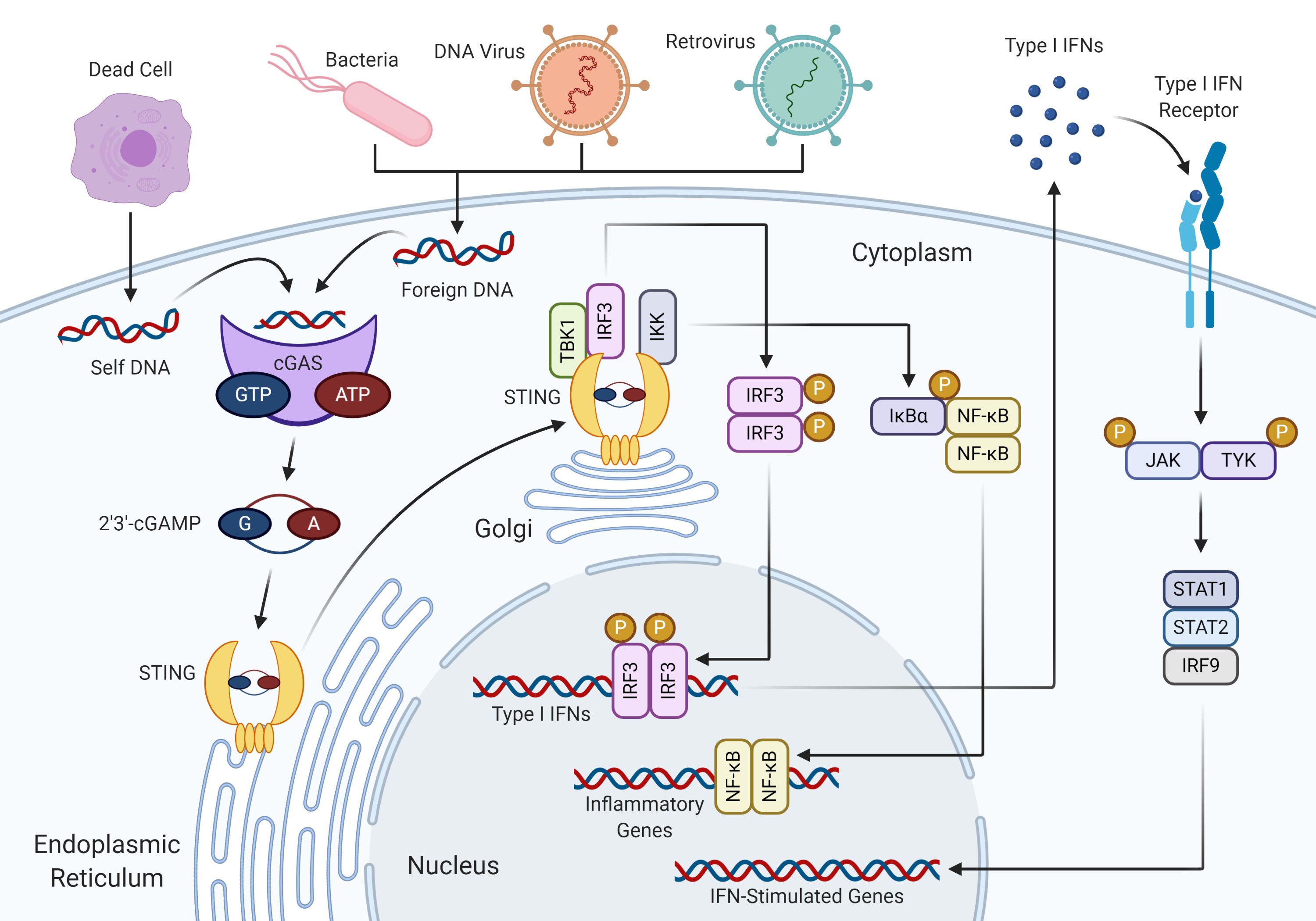The cGAS-STING Pathway in Inflammatory Lung Disease

Diagram of DNA sensing and signaling by the cGAS-STING signaling pathway, leading to expression of type I interferons and inflammatory cytokines. Created with BioRender.com. From Ma et al. 2020.
In eukaryotic cells, DNA normally resides in the nucleus and mitochondria. The aberrant presence of DNA in the cytoplasm therefore signals either infection with pathogens (such as bacteria, DNA viruses, or retroviruses [1-5]) or self-DNA accumulated from cellular damage [6-8]. Cytoplasmic DNA thus elicits robust immune responses, which are both beneficial and detrimental to the host.
The most robust response to cytoplasmic DNA is type I interferon (IFN) induction, which is initiated by cyclic GMP-AMP synthase (cGAS). Discovered in 2013 as the universal cytosolic DNA sensor, cGAS is enzymatically activated upon binding to double-stranded DNA (dsDNA) [9].
Active cGAS catalyzes ATP and GTP into 2′3′-cGAMP, which then binds to and activates the adaptor protein STING (also known as TMEM173, MITA, ERIS, and MPYS). Upon binding to cGAMP, STING undergoes conformational changes that induce translocation from the endoplasmic reticulum to the Golgi [10].
After trafficking to the Golgi, STING recruits and activates TANK-binding kinase 1 (TBK1). Recruited TBK1 directly phosphorylates the C-terminal tail of STING. Phosphorylated STING further recruits IFN regulatory factor 3 (IRF3) for its phosphorylation and activation by TBK1. Activated IRF3 forms a dimer and translocates to the nucleus to regulate the transcription of the type 1 IFN gene, IFNB1, which encodes IFN-β [10].
By binding to its receptor, secreted IFN-β activates the janus kinases (JAKs)-signal transducer and activator of transcription (STAT) signaling pathways to upregulate the transcription of IFN-stimulated genes in a positive feedback loop. In parallel, the cGAS-STING pathway can also activate NF-κB-dependent signaling transduction, thus regulating the transcription of genes encoding inflammatory cytokines [10].
Sustained self-DNA accumulation due to defective clearance by DNAses or leakage from the nucleus or mitochondria due to cellular damage leads to excessive activation of cGAS-mediated immune responses. The process can result in ischemic injuries, trauma, cancer, or severe autoimmune disease such as Aicardi-Goutières syndrome (AGS) and systemic lupus erythematosus (SLE) [10].
Many studies directly demonstrate that self-DNA accumulation is associated with lung diseases such as cystic fibrosis, chronic obstructive pulmonary disease, idiopathic pulmonary fibrosis, and asthma. Targeting the cGAS-STING pathway therefore provides potential avenues for treatment of these or possibly other chronic inflammatory lung conditions, including those associated with COVID-19 [10].
- Cheng et al., The cGAS-STING signaling pathway is required for the innate immune response against Ectromelia virus, Front Immunol, 2018 (PMID: 29963044).
- Ma et al., Modulation of the cGAS-STING DNA sensing pathway by gammaherpesviruses, Proc Natl Acad Sci U S A, 2015 (PMID: 26199418).
- Schoggins et al., Pan-viral specificity of IFN-induced genes reveals new roles for cGAS in innate immunity, Nature, 2014 (PMID: 24284630).
- Gao et al., Cyclic GMP-AMP synthase is an innate immune sensor of HIV and other retroviruses, Science, 2013 (PMID: 23929945).
- Mankan et al., Cytosolic RNA:DNA hybrids activate the cGAS-STING axis, EMBO J, 2014 (PMID: 25425575).
- Gao et al., Activation of cyclic GMP-AMP synthase by self-DNA causes autoimmune diseases, Proc Natl Acad Sci U S A, 2015 (PMID: 26371324).
- Benmerzoug et al., STING-dependent sensing of self-DNA drives silica-induced lung inflammation, Nat Commun, 2018 (PMID: 30523277).
- Nascimento et al., Self-DNA release and STING-dependent sensing drives inflammation to cigarette smoke in mice, Sci Rep, 2019 (PMID: 31619733).
- Sun et al., Cyclic GMP-AMP synthase is a cytosolic DNA sensor that activates the type I interferon pathway, Science, 2013 (PMID: 23258413).
- Ma et al., The cGAS-STING pathway: The role of self-DNA sensing in inflammatory lung disease, FASEB J, 2020 (PMID: 32860267).